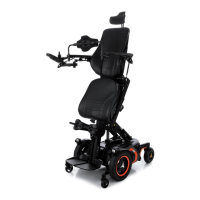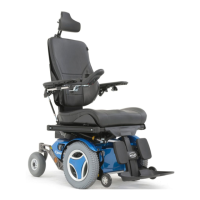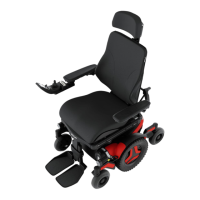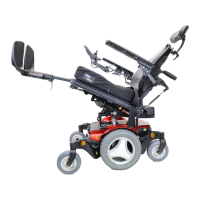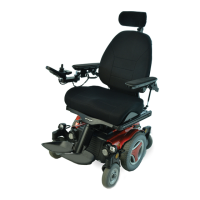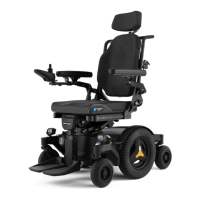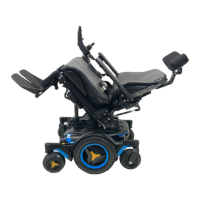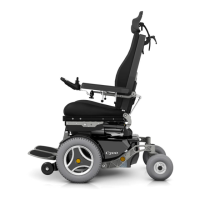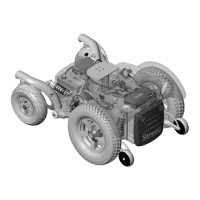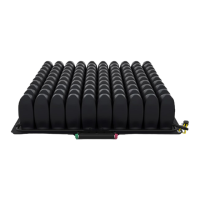Why does my Permobil F3 Corpus Wheelchair stop while driving?
- DDaniel HolmesSep 9, 2025
If your Permobil Wheelchair stops while being driven, it might be because the main circuit breaker has tripped. Try resetting the main circuit breaker once.
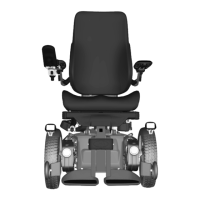
Why does my Permobil F3 Corpus Wheelchair stop while driving?
If your Permobil Wheelchair stops while being driven, it might be because the main circuit breaker has tripped. Try resetting the main circuit breaker once.
Why my Permobil Wheelchair can only be driven at reduced speed?
If your Permobil Wheelchair can only be driven at reduced speed, a seat function might have triggered the automatic speed restriction. Make sure that the backrest and the leg rest are not tilted and that the seat is not tilted or lifted.
How to troubleshoot if my Permobil Wheelchair does not start?
If your Permobil Wheelchair isn't starting, there are several potential causes. First, the batteries might be discharged, so charge them. Alternatively, the cable connection to the control panel may have come loose; ensure the cable is securely inserted into the control panel. Another possibility is that the main circuit breaker is turned off, in which case you should turn it on. Also, the main circuit breaker may have tripped; try resetting it once.
| Drive Wheel Position | Mid-wheel drive |
|---|---|
| Weight Capacity | 300 lbs (136 kg) |
| Frame Material | Steel |
| Drive Wheels | 14 in (350 mm) |
| Caster Wheels | 8 inches |
| Wheel Size | Drive Wheels: 14 in (350 mm), Casters: 6 in (150 mm) |
| Battery Life | Varies based on usage, typically 1-2 years |
| Seat Width | 17 - 22 in (43 - 56 cm) |
| Seat Height | 17.5-22.5 inches |
Details the two-year product guarantee and one-year battery/charger guarantee.
Guidance on contacting Permobil for technical assistance and cyber security.
Procedure for reporting incidents and ordering user manual copies.
Information on ordering spare parts and scrapping/recycling agreements.
Explanation of warning, remark, and text symbols used for safety.
Safety advice regarding operation, driving, obstacles, and vehicle parts.
Guidance and risks associated with driving on slopes, turning, and free-wheel mode.
Factors affecting tipping risks and centre of balance.
Safety precautions for transferring and transporting the wheelchair.
Safety guidelines for charging batteries and replacing components.
Diagram and list of the F3 Corpus wheelchair's main components.
Detailed technical specifications including product name and class.
Guide to understanding the meaning of various labels on the wheelchair.
Description of the wheelchair's design and functional aspects.
Overview of powered seat functions like lift, tilt, and recline.
Overview of R-Net LCD and LED control panel features and operations.
Details on Bluetooth® mode operation and IR mode functionality.
Guide to adjusting various wheelchair components for optimal use.
Instructions for adjusting headrest, backrest, and lumbar support.
Instructions for adjusting armrests and leg supports.
Instructions for adjusting footplates and knee supports.
General instructions for operating the wheelchair indoors and outdoors.
Guidance on driving techniques and restrictions on various surfaces.
Detailed procedures and safety warnings for charging wheelchair batteries.
Guidelines for safely transporting the wheelchair in vehicles and by air/rail.
Schedule for daily, weekly, monthly, and yearly maintenance checks.
Methods for regular cleaning of metal, plastic, and upholstery.
Procedure for safely removing and installing wheelchair batteries.
Procedures for maintaining drive wheels, including removal and installation.
Procedures for maintaining castor wheels, including removal and installation.
Information on the main circuit breaker and brake release checks.
Location and description of serial number labels on the wheelchair.
Information on the Dahl Docking System MKII.
Requirements for support wheels and seat depth based on user weight.
Table detailing conditions that trigger speed restrictions or drive inhibition.
Table detailing conditions that limit seat lift, tilt, recline, and leg support movement.
Guide to common faults, possible causes, and suggested remedies.
Diagnosing faults using the R-Net LCD control panel and its display.
Interpreting LED indicators on the R-Net LED control panel for faults.
Table of LED indications for faults and their corresponding remedies.
Information on repairing or replacing defective units with OEM-approved parts.

